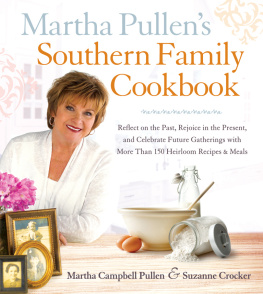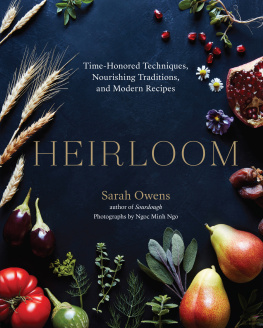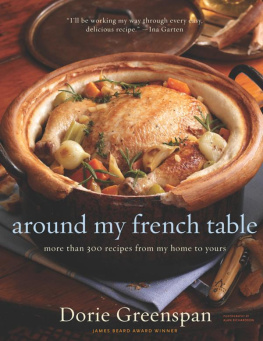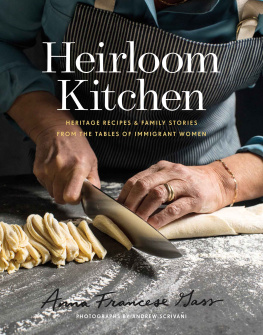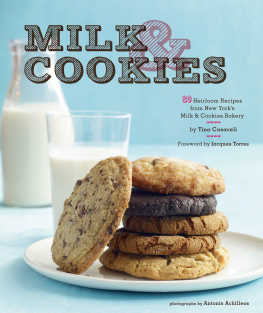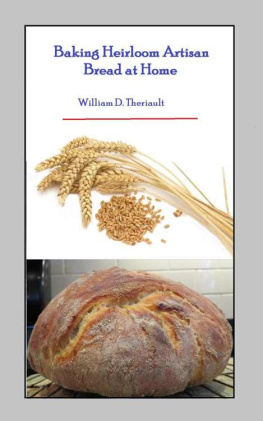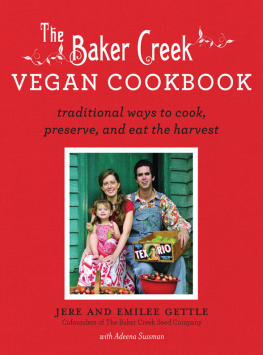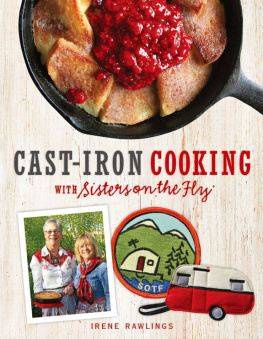Heirloom Cooking
WITH THE
Brass Sisters
Queens of Comfort Food
Recipes You Remember & Love
MARILYNN BRASS & SHEILA BRASS
Photographs by Andy Ryan

Copyright 2008 Marilynn Brass and Sheila Brass
Photographs copyright 2008 Andy Ryan
All rights reserved. No part of this book, either text or illustration, may be used or reproduced in any form without prior written permission from the publisher.
The Queens of Comfort Food is a trademark of WGBH, used with permission.
All rights reserved.
Consuming raw or undercooked meats, poultry, seafood, shellfiish or eggs may increase your risk of food-born illnesses.
Published by
Black Dog & Leventhal Publishers, Inc.
151 West 19th Street
New York, NY 10011
Distributed by
Workman Publishing Company
225 Varick Street
New York, NY 10014
Cover design by Susi Oberhelman
Photographs by Andy Ryan
Food Styling by Catrine Kelty
Kitchen Antiques by Marilynn and Sheila Brass
eISBN: 978-1-60376-364-6
Library of Congress Cataloging-in-Publication Data is available on file.
: Cheese Bread
To our three Barbaras
Barbara Carey, Barbara Haber, and Barbara Wheaton
with love
C ONTENTS
P REFACE
We are two roundish bespectacled women who have a combined total of 114 years of home cooking experience. We have always felt comfortable in the kitchen because we learned to cook at a very early age. Our mother, Dorothy, was an inspired home cook, and the meals she produced when we lived on Sea Foam Avenue, in Winthrop, Massachusetts, more than sixty years ago are still memorable.
Working at the black cast iron stove with its green enamel trim, we learned to ignore its idiosyncrasies to produce the soups and stews of our childhood, recipes we still make with pride today. We believe that there is nothing more comforting than the smell of a thick vegetable soup simmering on a back burner, a glistening brisket braising in the oven, or a dish of macaroni and cheese with its golden crust of buttery crumbs. We still relive the glories of the appetizers, vegetables, salads, and main dishes that came out of that sunny kitchen to become satisfying home-cooked meals. When we want to replicate these precious family recipes, we go to Mamas first cookbook, All About Home Baking, fragile now, but priceless, with her handwritten recipes on the front and back pages.

Sheila, third grade, 1943; Marilynn, first grade, 1948
We couldnt have written Heirloom Cooking without consulting our manuscript cookbooks, those treasured notebooks of personal recipes compiled by home cooks. It is these living recipes, these notes handwritten on crumbling scraps of paper or the pages of old, well-worn cookbooks that inspire us to interpret the lost recipes and family stories of others. We continue to find these recipe collections, gathered together in bundles or in small boxes at yard sales, in used bookstores, or on the pantry shelves of friends.
Our personal collection of manuscript cookbooks has grown from 85 to 150 over the past two years. Because we are women of the twenty-first century, we have launched our own Web site ( www.thebrasssisters.com ) to communicate with our new friends, exchange recipes and family stories, and answer culinary questions.
In Heirloom Cooking, we give you the choice of planning and serving an entire heirloom meal or preparing a special heirloom dish from primary sources, the recipes handwritten by home cooks from all over the United States and Canada. The recipes we present are culturally diverse and tempting, from a German sauerbraten recipe from Ohio to a sophisticated liver pat from New York City. Discover Arline Ryans Swedish Meatballs with Sour Cream Sauce from Indiana, Sweet Potato Pudding from North Carolina, Elinors Shrimp Creole from Florida, and Danish Roast Goose Stuffed with Apples and Prunes and served with Red Cabbage and Caramelized Potatoes from Minnesota. Scottish baps appear as well as sweet and sour cabbage rolls and French-Canadian tortire. Mrs. Fredmans Coleslaw, from our childhood, is represented right along with Southern Icebox Pickles. For dessert we present a colorful choice of Red Velvet Cake, Green Tomato Pie, and a New England Blueberry Buckle, as well as other classic home-baked desserts.
We also pay tribute to the inexpensive vegetarian meals that utilized and celebrated the bounty of backyard gardensthose dumplings, frittatas, and pancakes that often served as main dishes in families that had more love in their kitchens than money in their purses.
Heirloom Cooking contains chapters on appetizers, soups, salads, vegetables, breads, and main dishes, as well as a respectable number of pies, cakes, and cookies. We have interpreted these handwritten recipes so that you can reproduce them in your own home kitchen, and weve tried to simplify the ones that once took hours or days to put together. To do this, weve turned to the culinary tools of twenty-first-century Americathe mixer, the food processor, and occasionally, the microwave oven. Some recipes, such as those for bagels, have been scaled down and reinterpreted so that you will be able to prepare a home version of something that was usually produced in large quantities commercially. Not only have we kept it simple, weve also given you the freedom to adjust the seasonings, the size of the portions, and the cooking times. Please remember that the more exotic dishes, such as curries and pats, are interpretations of how an heirloom cook would have prepared these dishes in her own home kitchen. The recipes for roast goose and sauerbraten require more time to prepare and would have been served on special occasions.
What has influenced our appreciation of heirloom cooking the most has been the culinary journey weve taken across America. Weve traveled through the South, the Midwest, and New England meeting old friends and making new ones. It was a sentimental journey because these visits with home cooks all over America have reinforced our belief that every family has a story and a recipe to document its own personal history. Sometimes the stories are sad, sometimes they are funny, but all are touching.
For us, traveling across America was a movable feast. We shared chicken pot pie in St. Louis, and we ate pierogi and stuffed cabbage in Ann Arbor. We learned about a Danish-American boy from Minneapolis who, upon losing his mother when he was fifteen years old, learned to cook the substantial meals needed to sustain his construction worker father. We were told of a young girl who, married at age fourteen to a Russian Orthodox priest, fed her five children her delicious cheese and farina dumplings between entertaining the bishop and ironing the church linen. There was the sprightly white-haired woman in Philadelphia, with a no-nonsense haircut and merry blue eyes, who advised us to add brewed coffee to our soups and gravies to give them a richer color. Later, we found the same advice in a Southern cookbook from the 1870s.
These encounters were precious, but the message was always the same. Cooking is the way we show our love for others. Its the way we nurture and support our family and friends. Heirloom cooking is just another definition for comfort food.
We have provided you with a keepsake envelope in the back of Heirloom Cooking as well as a special chapter of blank lined pages on which to transcribe the stories and recipes of your own family. We encourage you to listen to each story, write down the recipe, and make the book your own. Have fun cooking!
Next page

